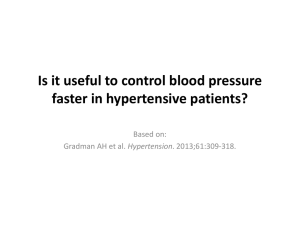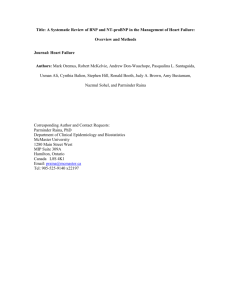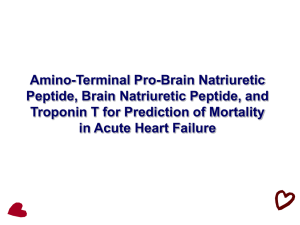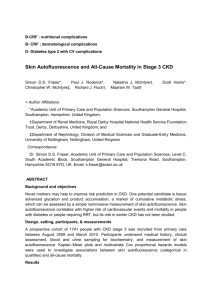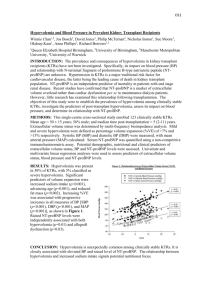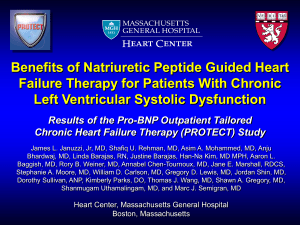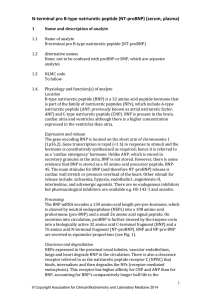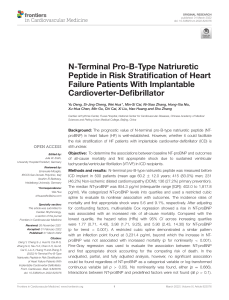“Association of Copeptin and N-Terminal proBNP Concentrations
advertisement
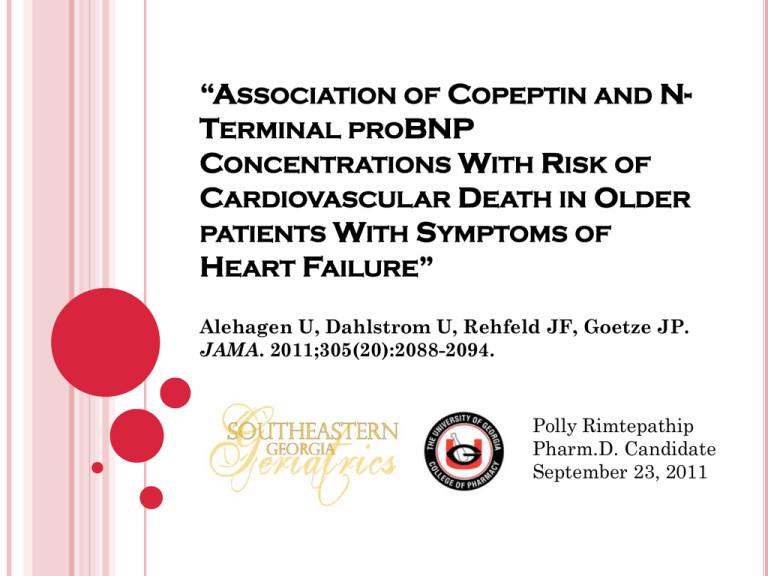
“ASSOCIATION OF COPEPTIN AND NTERMINAL PROBNP CONCENTRATIONS WITH RISK OF CARDIOVASCULAR DEATH IN OLDER PATIENTS WITH SYMPTOMS OF HEART FAILURE” Alehagen U, Dahlstrom U, Rehfeld JF, Goetze JP. JAMA. 2011;305(20):2088-2094. Polly Rimtepathip Pharm.D. Candidate September 23, 2011 FUNDING Grants from the County Council of Ostergotland, the Swedish Heart and Lung Foundation, and the University of Linkoping OBJECTIVE To evaluate the association of combined plasma copeptin and N-terminal fragment of the precursor to B-type natriuretic peptide (NTproBNP) concentrations with mortality in elderly patients with symptoms of heart failure BACKGROUND B-type natriuretic peptide (BNP) Secreted by the ventricles of the heart in response to excessive stretching of heart muscle cells or cardiomyocytes. co-secreted with N-terminal fragment (NT-proBNP) which is biologically inactive NT-proBNP Precursor of BNP Its half-life is longer than the BNP (1-2 hrs vs 20 mins) Both BNP and NT-proBNP levels in the blood are used as markers for heart failure (HF) Both levels increases when HF symptoms worsen and decreases as heart failure condition is stable BACKGROUND Vasopressin A non-cardiac plasma marker of cardiovascular disease Released from the neurohypophysis (posterior pituitary) in response to changes in plasma osmolality and is involved in osmoregulation and cardiovascular homeostasis The plasma concentration of vasopressin increases in patients with HF and is associated with left ventricular dysfunction. Copeptin C-terminal fragment of the arginine vasopressin (AVP) precursor hormone circulating copeptin levels reflect the activity of the AVP system and correlate closely with plasma osmolality BACKGROUND Vasopressin is not a useful plasma marker because it rapidly degrades in the circulation Therefore, copeptin, a provasopressin, has emerged as a promising measurement in place of vasopressin concentration Measurements of copeptin has been mainly tested in patients with severe infection, and some reports suggested its possible role in cardiovascular disease As a result, this study was designed to look at the copeptin’s role in combination with NT-proBNP concentrations in predicting clinical outcomes of elderly patients with HF symptoms STUDY DESIGN Conducted between January and December of 1996 with follow-up through December 2009 (13-year follow-up) 1-center, prospective cohort study Setting Sample All elderly patients aged 65-87 years with symptoms and/or signs of heart failure were evaluated Sample size A primary health care center in southeast Sweden 470 patients participated with the mean age of 73 years old and an equivalent distribution of men and women. Symptoms and/or signs of HF included shortness of breath, peripheral edema and/or fatigue. METHODS For each patient, a new patient record was started and clinical examination was performed: New York Heart Association (NYHA) functional class Doppler echocardiography Standard blood analyses HF was diagnosed as a combination of symptoms and/or signs and an ejection fraction < 40% on echocardiography. Mortality information was obtained from the Swedish National Board of Health and Welfare, which registers all deaths of Swedish citizens. STATISTICAL ANALYSIS Descriptive data are presented as percentages or means with standard deviations. Analyses were calculated using an unpaired 2sided t test for continuous variables. 2 The X test was used for discrete variables. Evaluation of correlation was analyzed using the Pearson product-moment correlation coefficient. Cox proportional hazard regression analyses were used to analyze the risk of both all-cause and cardiovascular mortality during the followup period. STATISTICAL ANALYSIS X2 test (chi-square) Used with discrete data to test the null hypothesis A statistical method for determining the approximate probability of whether the results of an experiment may arise by chance or not. The test is performed by first creating a 2X2 contingency table of the observed disease and test outcome frequencies. Uses – to determine whether the distributions of two variables are independent of each other and to test a sample against an expected distribution MAIN OUTCOME All-cause mortality and cardiovascular mortality RESULTS RESULTS During the follow-up, there were 226 deaths (48%) from all causes with 146 cardiovascular deaths (31%). Concentrations of copeptin and NT-proBNP were associated with long-term all-cause mortality, both separately and in combination Prognostic information obtained by the markers was greater when both were combined RESULTS 44 of 52 patients (84.6%) were correctly identified as high risk in the group with both markers in the highest quartiles, compared with 99 of 287 patients (34.5%) with all-cause mortality and concentrations of both markers in the first quartile. 36 of 52 patients (69.2%) were correctly identified as at high risk with both markers in the highest quartiles, compared with 61 of 287 (21.3%) with cardiovascular mortality and concentrations of both markers in the first quartile. RESULTS In all-cause mortality, when both markers were evaluated together, 6.8% more patients were correctly identified as at risk compared with only using NT-proBNP concentration over a 13-year follow-up period 8.4% more were correctly identified in 10 years follow-up In cardiovascular mortality over 13 years, 12.3% more were correctly identified as at risk 19.6% more were correctly identified in 10 years follow-up. DISCUSSION Additive prognostic information was demonstrated for both all-cause and cardiovascular mortality. Both NT-proBNP and copeptin provided independent prognostic information. Because of the nature of the sample population, the study more accurately represent the population with heart failure seen in primary care. DISCUSSION The study can help with the interpretation of symptoms of heart failure in elderly patients because they often present with other diseases, which could make the interpretation difficult. The data suggests that vasopressin may be a potential target for therapeutic intervention. CONCLUSION Concentrations of copeptin and NT-proBNP together can provide a prognostic information in elder patients with symptoms of heart failure. Elevated level of copeptin and NT-proBNP were associated with increased risk of all-cause mortality. COMMENT NT-proBNP was an established marker of heart failure, but when evaluate the concentration along with copeptin concentration, the accuracy level increases. However, the clinical significance of the outcome need to be evaluated Cost versus benefit analysis of using the two markers instead of one will be helpful in practice. The study opens the door to other researches regarding the roles of copeptin in heart failure and other diseases other than severe infection.

